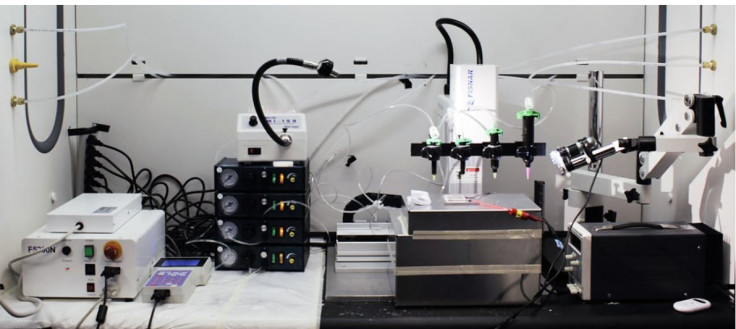Future Of 3D Printing? Contact Lenses That Display Videos And Detect Health Problems

What’s around the next bend? Many futurists speculate 3D printing — where solid objects are created from digital design — is the next big thing, contributing to a radical shift in consciousness equal to the impact of the personal computer. While the eventual reality may be less fantastic than currently imagined, a team of Princeton researchers led by Dr. Michael C. McAlpine recently developed a 3D printer capable of making astoundingly complex five-layered contact lens able to display information or even videos, while also detecting the health problems of the wearer.
"I believe that 3D printing of multi-functional materials holds tremendous promise for a range of applications, including personalized biomedical devices and electronics," McAlpine told Medical Daily in an email. Notably, this research was funded by the United States Air Force which, according to New Scientist, hopes to someday equip their pilots with similar lenses that will display data and non-invasively monitor their in-flight well-being. "Planes have sensors for the state of everything, except the most important thing: the pilot's exhaustion level," McAlpine told the publication.
Imagine being able to manufacture whatever you want and to your exact specifications without a full-scale factory being involved. With the right materials, you would be able to customize every item or object you possess, from your shoes to the parts inside your microwave, to fit exactly your needs. While some foresee concise 3D printers in every home, others predict a service provider model — equivalent to paying a copy shop, say, which has invested in a large and expensive machine (as well as paper supplies) to help you photocopy your documents. However, McAlpine’s vision of the uses of 3D printing is far more expansive, much more revolutionary.

Using a 3D bioprinter he has made a synthetic ear by depositing live cells and conductive silver in layers. “It will just be considered normal that you have electronics embedded in your body,” McAlpine told Wired. “You won’t think it’s weird that a door will just open up as you walk towards it. We will become cyborgs and it will be seen as just a normal thing.”
Welcome to Tomorrow
While so far “3D printing has been limited to specific plastics, passive conductors, and a few biological materials,” McAlpine’s newest contact lens project was meant to show how, as he wrote in his published study, “diverse classes of materials can be 3D printed and fully integrated into device components with active properties.”
Specifically, the new contact lenses he created and 3D printed are made of a transparent polymer embedded with several components, including quantum dot light-emitting nanoparticles that exhibit pure and tunable color emission properties; solid and liquid metal leads; and organic polymers. Even more wild is the fact that McAlpine’s 3D printed contact lenses, just like those currently created for people with poor vision, conform to a user’s prescription. Apparently, the research team continuously scanned the lens to guarantee the final shape matched the contours of the user’s eyes.
Dramatic as these contact lenses may be, McAlpine's other projects are equally if not even more exciting. To understand his unique vision, watch this video:
Published by Medicaldaily.com



























